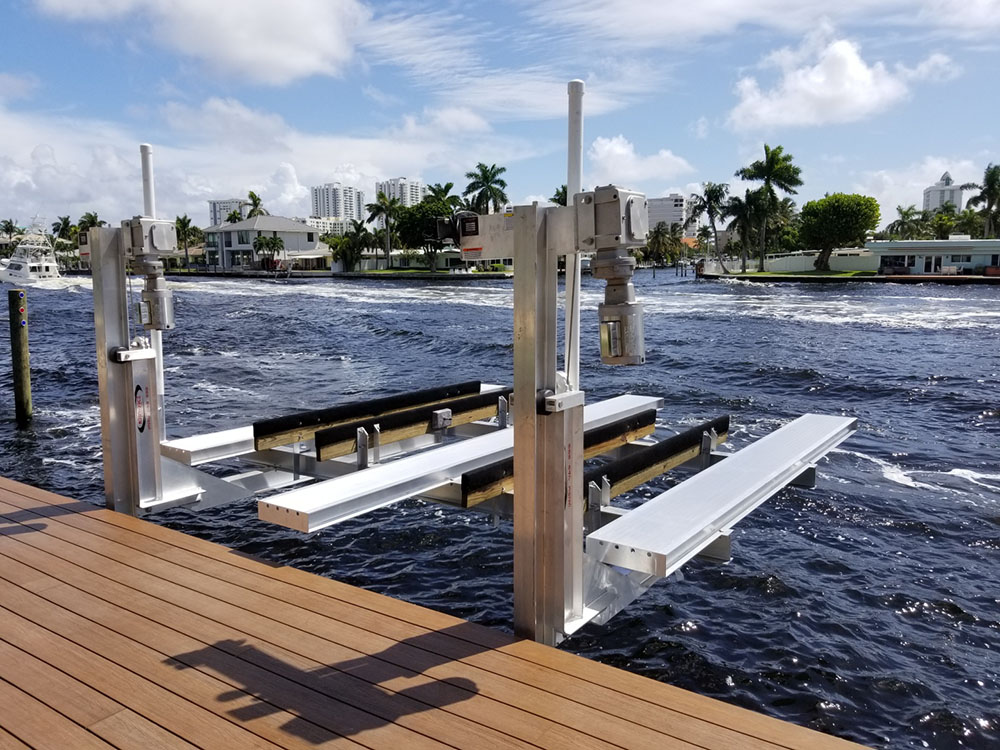
Having a boat lift as part of your dock construction makes things a lot easier. However, all the convenience goes away if your lift isn’t working properly. You must maintain your boat lift so that it continues to work properly. Careful maintenance ensures that your lift lasts for the long haul. Ignoring some of the most fundamental maintenance tasks causes damage that can be costly to repair. Here are some general tips and guidance on how to maintain a boat lift.
General Boat Lift Maintenance
Lift Cables
You should regularly inspect the lift cables to check for wear and tear. Check to ensure the cables are winding as they should. Broken strands, rusty areas, kinks, fraying, and other abnormalities are signs that you should consider replacing your lift cables. We recommend contacting a professional contractor if you notice wear and tear in your cables. Get an expert to assess the cables and see if they need to be replaced.
Another way to care for your lift cables is to wash them with fresh water when you finish with the lift. Saltwater corrodes lift cables and drastically reduces their lifespan if left on the cables. You should rinse them between uses to keep them clean and ensure your boat installation lasts for years to come.
Also, you might want to lubricate the lift cables with a penetrating oil. Individual strands inside the cable tend to rub against each other when you use the cable. This causes abrasions and wears down the inside and outside of the cable. Penetrating lubricants offer protection against corrosion and lubricate the core inner strands and exterior surfaces. They also remove dirt and other contaminants from the outside of the cable. Lubricating your cables is a great way to ensure they last longer.
When thinking about dock building, stainless steel cable manufacturers recommend that you replace galvanized cables every two years, even if there are no obvious signs of wear and tear. Failing to effectively maintain your lift cables could cause serious issues that damage your dock and lift, damage your boat, or cause personal injury. The risk of using your cables longer than intended isn’t worth it.
Lift Beams
As with the cables, you should rinse your lift beams with fresh water when you use the lift. Freshwater helps eliminate saltwater and barnacles to reduce damage. If you don’t care for your beams or rinse them regularly, the barnacles and salt start to build up. They then cause the beam to corrode and get progressively weaker. The easiest way to eliminate saltwater and barnacle-related wear is to keep your beams out of the water when not in use.
 Bunks
Bunks
Give your bunks a look every so often to check for tears and wear in the carpet. Also check the wood to see if there are any cracked, broken, and rotten areas. Check the bunk brackets for damage such as cracks or wear and tear. Adjust the position of your bunk brackets if you need to and tighten all the hardware. Carpeted wood bunks need to be replaced periodically because of their continued exposure to water.
Drive Units and Gearboxes
You should check your gears once a month to ensure they are properly greased. The last thing you need is a drive unit seizing up because it wasn’t greased enough. If you notice a flat plate drive, then remove the covers and see if the belts are loose, frayed, or broken. If you see visible signs of this damage, then we recommend that you immediately replace the belts. Also, check the alignment of the belt while you’re there and adjust it if necessary.
Check the motors to see if there are any signs of rust. Pay close attention to the capacitor cover while looking. If your motors aren’t kept under a cover, then check to see if the motor is retaining water or not. Ensure that the topside drain holes are fully closed and that the bottom-side drain holes are open and free from debris so that water drains effectively. Top-quality American-made motors generally last for up to ten years when protected by a cover. Cheaper stainless-steel motors can only for one or two years without a cover.
Pulleys
Make sure you check the pulleys/sheaves for grease. If the bolts and sheaves aren’t greased properly every four to six months, depending on how often you use them, then friction builds up between the sheaves and the mounts. This friction causes the sheaves to start squeaking and eventually causes them to seize up. Check the nuts and bolts while you’re at it to ensure they are tight enough. One loose bolt is all it takes to cause heaps of problems.
Drive Pipe Bearing Block
You’ll want to grease the grease points on the motors every four to six months. This keeps the parts working at optimal levels. A lack of grease means that more friction builds up between the bearing and drive pipe, which increases the risk of catastrophic failure. If the bearing blocks are bolted to the top beams, then you should also check that the nuts and bolts are all tightened properly.
Wired Zincs
If your boat lift is an elevator style one, then inspect the wired zincs to ensure they are always fully submerged. Check the zincs and replace them if they are over 50% worn.
Final Thoughts
Follow these helpful boat lift maintenance tips to ensure that you get the most out of your boat lift, save money on repairs, and spend more time on the water with your boat. If you don’t have all that time or want to leave it to the professionals, then Loggerhead Marine Services can help. Our team is ready and waiting to answer your questions. We will arrange for maintenance and repairs if you need them.
